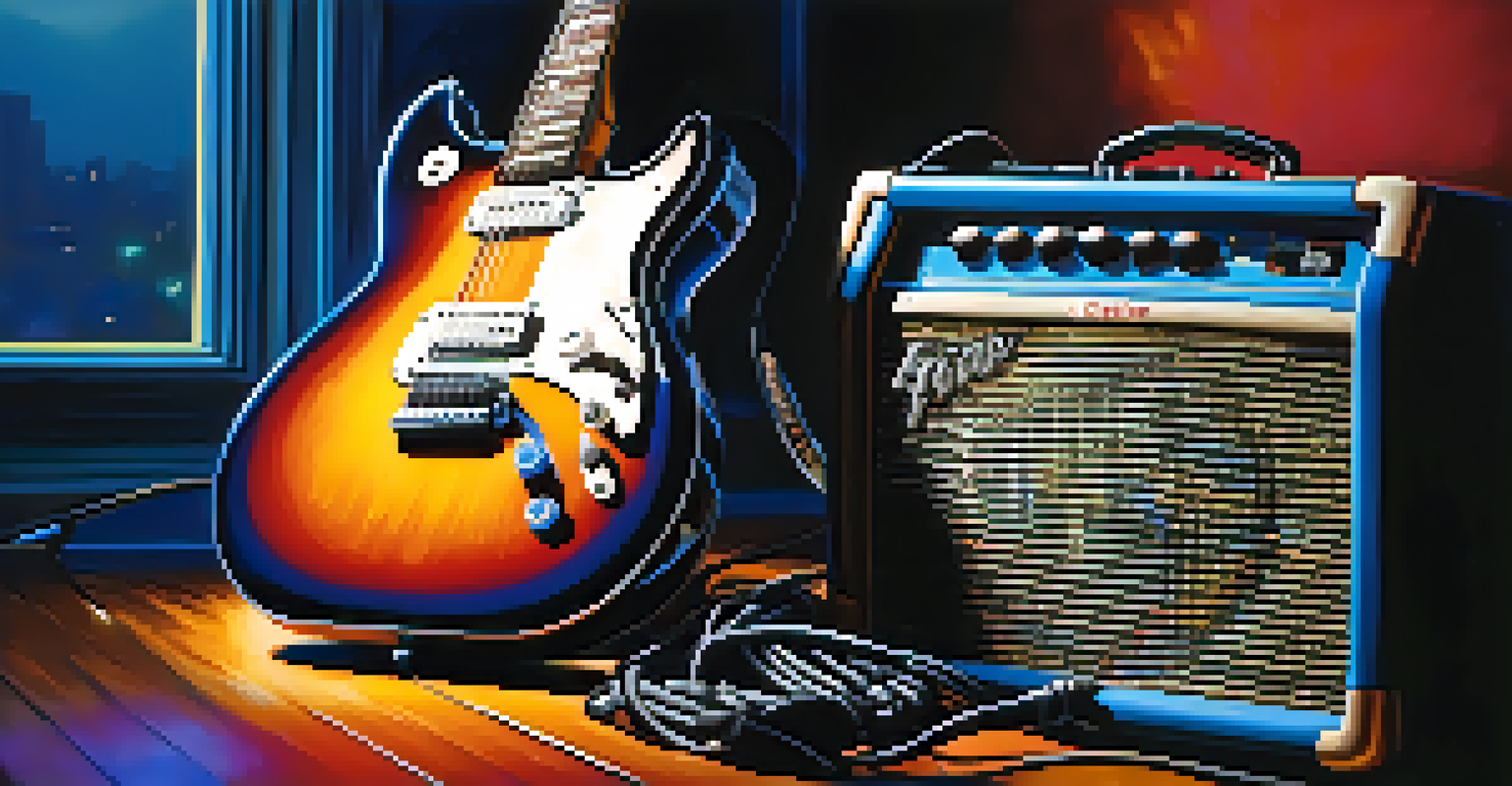The Evolution of Guitar Techniques in Modern Music

The Birth of Guitar Techniques in Early Music
In the early days of music, the guitar was often seen as a secondary instrument, mainly accompanying singers or other instruments. Its techniques were simplistic, focusing on basic strumming and chord progressions. However, as music evolved, so did the guitarist's role, paving the way for more intricate playing styles. This shift marked the beginning of a rich and diverse evolution in guitar techniques that would shape future genres.
The guitar is a small orchestra. It is polyphonic. Every string is a different color, a different voice.
The transition began in the late 19th century with the rise of classical guitar, which introduced fingerpicking and more complex melodic lines. Composers like Francisco Tárrega showcased the guitar's potential as a solo instrument, inspiring musicians to explore its capabilities. This period was crucial as it laid the groundwork for the technical advancements that would follow in modern music.
As the 20th century approached, jazz and blues musicians began to experiment with the guitar, incorporating techniques like bending notes and slide playing. These innovations not only added emotional depth to their performances but also influenced countless genres, from rock to R&B. The guitar was no longer just an accompaniment; it was becoming a leading voice in modern music.
The Rise of Electric Guitar Techniques
The invention of the electric guitar in the 1930s revolutionized how the instrument was played and perceived. Suddenly, guitarists could produce louder sounds and experiment with various effects, like distortion and reverb. This opened up a world of possibilities, allowing for the development of new techniques such as palm muting and tapping, which became essential in rock music.

Icons like Chuck Berry and Jimi Hendrix helped popularize these electric guitar techniques, inspiring a generation of musicians to push boundaries. Their innovative styles not only showcased technical prowess but also brought a new level of expressiveness to the guitar. This period was marked by a fusion of different genres, with guitarists borrowing techniques from blues, jazz, and classical music.
Evolution of Guitar Techniques
Guitar techniques have transformed from simple strumming to intricate playing styles, influenced by various genres and historical shifts in music.
As rock music exploded in popularity, guitar techniques continued to evolve. The emergence of heavy metal introduced aggressive techniques like sweep picking and harmonics, while punk rock favored raw, powerful power chords. Each genre contributed to a diverse toolkit of techniques that guitarists could draw from, enriching the fabric of modern music.
Fingerstyle and Hybrid Techniques in Contemporary Music
In recent decades, fingerstyle guitar has gained recognition as a legitimate technique in various genres, including folk, pop, and even rock. Artists like Tommy Emmanuel and Andy McKee showcase the beauty of fingerpicking, integrating intricate melodies and harmonies into their performances. This technique allows for a more intimate connection with the audience, as the guitarist becomes both a rhythm and melody player simultaneously.
Music is the shorthand of emotion.
Hybrid techniques, which combine fingerpicking with flatpicking, have also become increasingly popular. This approach allows guitarists to switch between styles seamlessly, enhancing their versatility. Artists like John Mayer and Ed Sheeran have mastered this technique, using it to create rich soundscapes that captivate listeners.
The influence of technology, such as loop pedals and digital effects, has further propelled the evolution of guitar techniques. These tools enable musicians to layer sounds, creating complex compositions that were once only possible with a full band. Today, guitarists are not just players; they are composers and producers, blending various techniques to craft unique musical experiences.
The Impact of Social Media on Guitar Techniques
Social media has transformed how guitar techniques are shared and learned. Platforms like YouTube and Instagram have created a space for guitarists to showcase their skills and innovative techniques to a global audience. Aspiring musicians can now learn from their favorite artists through tutorials, breaking geographical barriers and democratizing music education.
The rise of online guitar communities has also fostered collaboration and experimentation. Guitarists share videos that highlight new techniques, from unusual finger placements to unique rhythmic patterns. This exchange of ideas encourages creativity and pushes musicians to expand their skill sets, leading to the birth of new styles and techniques.
Impact of Technology
Advancements in technology, such as digital effects and online platforms, have significantly enhanced guitarists' ability to experiment and collaborate.
Moreover, social media challenges traditional music industry norms. Many musicians are now able to build their careers independently, using their unique guitar techniques to stand out. This shift has led to a more diverse music landscape, where innovation and authenticity are celebrated, shaping the future of guitar in modern music.
Genre-Specific Techniques: A Deeper Dive
Each music genre has its own set of guitar techniques that define its sound. For instance, in country music, techniques like chicken picking and fingerpicking create a distinct twang that resonates with fans. Renowned guitarists such as Brad Paisley and Chet Atkins have perfected these styles, showcasing their technical prowess and artistry.
In contrast, jazz guitarists often employ techniques like chord melody and improvisation. These methods not only enhance the harmonic structure of a piece but also allow for personal expression within the music. Artists like Wes Montgomery and Joe Pass have made significant contributions to jazz guitar, inspiring countless musicians to explore the genre's complexities.
Similarly, in metal music, advanced techniques like alternate picking and legato playing are crucial for achieving speed and precision. Guitarists like Steve Vai and Paul Gilbert have elevated these techniques, pushing the limits of what is possible on the instrument. Understanding genre-specific techniques helps musicians appreciate the diversity of guitar playing and its impact on modern music.
The Role of Technology in Modern Guitar Techniques
Technology has played a pivotal role in shaping modern guitar techniques. The introduction of digital effects, amplifiers, and recording software has allowed musicians to experiment with sound in ways that were previously unimaginable. Guitarists can now easily manipulate their tone, creating unique sounds that define their musical identity.
Moreover, guitar modeling technology has revolutionized practice and performance. Musicians can emulate various amplifiers and effects without needing the physical equipment, making it more accessible to explore different sounds. This technological advancement encourages experimentation, allowing guitarists to discover new techniques and styles.
Social Media's Role in Learning
Social media has democratized music education, allowing aspiring guitarists to learn innovative techniques from a global community.
Additionally, online platforms for music production have enabled guitarists to collaborate remotely, blending techniques and styles from different genres. This fusion of influences has led to innovative music that pushes the boundaries of traditional guitar playing. As technology continues to evolve, we can expect even more exciting developments in guitar techniques.
Looking Ahead: The Future of Guitar Techniques
As we look to the future, it’s clear that guitar techniques will continue to evolve alongside music trends. With the rise of genres like electronic and experimental music, guitarists are likely to integrate new techniques that blend traditional playing with modern technology. This fusion will not only keep the guitar relevant but also expand its possibilities as an instrument.
Furthermore, the increasing popularity of online music education suggests that more musicians will explore diverse guitar techniques. This accessibility will encourage a new generation of players to innovate and push the boundaries of what the guitar can do. The sharing of ideas and techniques across platforms will continue to inspire creativity and collaboration.

Ultimately, the evolution of guitar techniques reflects the dynamic nature of music itself. As artists continue to experiment and redefine their craft, the guitar will remain a powerful tool for expression, connecting musicians and audiences in new and exciting ways. The journey of guitar techniques is far from over, and we can’t wait to see where it leads next.